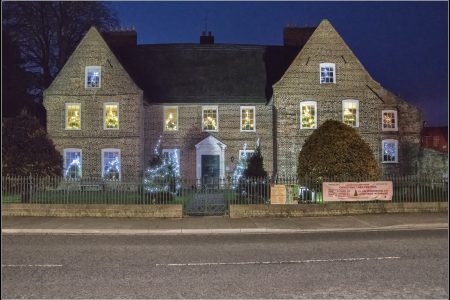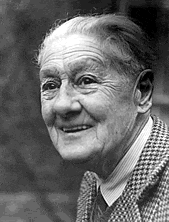

Alford Manor House is the historic focal point of the town, along with St. Wilfrid’s Church. It has links, through its American Connections exhibition, with many notable figures of the past: Anne Hutchinson, the famous female preacher and founder of Rhode Island; John Smith, who was a pupil at the local grammar school and the founder of the American colony of Jamestown, and the first governor of Virginia; and with Thomas Paine, the author of the influential “Rights of Man”. Both Presidents Roosevelt and Bush were direct descendants of Anne Hutchinson. The Manor House was for many years the possession of the descendants of Sir Robert Christopher, whose effigy can still be seen in the chancel of St. Wilfrid’s Church.
It has been thought that the manor house was built in the 16th century by Thomas Tothby of Tothby Manor as a timber-framed building (Cooke 1988, 40) in an H-shaped plan, conforming to the typical layout of a hall between a high-status solar wing and a low status service wing. The house is then believed to have passed into the ownership of William Cawley, who subsequently sold it to Sir Robert Christopher. Many of the histories of Alford suppose that Sir Christopher, having bought the timber- framed house, then encased it in brick c.1661 (typical of such histories are Cooke 1988; Cousins 2000; Hallgarth 1978).
Timber framing is extremely rare in Lincolnshire, especially in the more rural areas of the county. The main vernacular form of timber framing in Lincolnshire is ‘mud and stud ’. This form of construction was economical in its use of timber, and was usually used for low-status housing. A mud and stud house typically consisted of slender timbers forming a frame, with wooden laths nailed onto a mid- rail and then covered with a mud and straw mix. Typically, a mud and stud house was one and a half storeys high with a central hearth and lobby entrance (Cousins 2000). It is, therefore, perhaps surprising that Maurice Barley (Barley 1952) classified the substantial three-storied Alford Manor House as an example of mud and stud construction. The description of the house as an unusual example of a high status mud and stud building has remained since Barley first suggested it, and is included in the very recent gazetteer of mud and stud buildings in Cousins’ book Lincolnshire Buildings in the Mud and Stud Tradition (2000).
From documentary records, it is only possible to trace the house and its owner with any certainty as far back as Sir Robert Christopher (late 17th century). How ever, it is likely that Sir Christopher bought the house from another Alford resident, William Cawley, as it is stated in Sir Christopher’s will that he did ‘…bequeath unto my dear daughter the Lady Sherard all that my Capital Messuage in Alford with all my land there which I purchased of William Cowley Esq. and his wife…’
In many of the histories of Alford and Lincolnshire, it is assumed that the original owner of Alford Manor House was Thomas Tothby of Tothby Manor, who subsequently sold the property to William Cawley. It was Dudding’s comprehensive book History of the Parish and Manors of Alford (1930) which first mentioned that Alford Manor House was built and owned by Thom as Tothby. This has since been accepted as fact; however, as Dudding did not provide a reference for this piece of information, it cannot be verified.
The Tothbys were an ancient and influential family in Alford throughout the medieval period, and Sir Christopher’s will also mentions that he bought land in Alford from a ‘Mr Touthebye’. The family had long owned Tothby man or as well as other local manors, and it is possible that they owned a high-status house in Alford from which to man age all manorial business, which would have originally have been managed from the other smaller manor houses. Dudding (1930) hypothesises that in the late 16th century, the Tothby family fell on hard times and thus had to sell off parts of their once-large estate.
However, there is no direct evidence, documentary or otherwise, that Alford Manor House was connected with the Tothby’s. To confuse matters, many members of the Tothby family were named Thomas, and with no firm date for the property’s construction, it is difficult to identify which individual was supposed to have ‘built’ Alford Manor House.
It is important to note that Alford Manor House was not, in fact, the manor house of Alford Manor. Like many Lincolnshire towns and villages, Alford did not consist of one single manor but was made up of several, some of which were in existence before the Norman Conquest, when the town of Alford came into being (Barley 1952). The five most ancient manors associated with Alford were the manor of Alford, the manor of Alford with Well, the manor of Rigsby with Tothby, and the man or of Saleby with Tothby (Dunning 1930, 4). Alford Man or House was never connected with the two purely Alford manors (the manor of Alford and the manor of Alford with Well), but could be regarded as the manor house of Sir Robert Christopher’s combined manors of Rigsby, Ailby and Tothby, which he purchased in the mid-17th century (Dunning 1930, 2).
Sir Robert Christopher came from a branch of the Christopher family originating from the north of England around County Durham, which had, during the reign of Queen Elizabeth, moved south to Stoke Prior, Worcestershire (Burke 1900, 295). His grand father had moved to Lincoln in the 16th century. After his grandfather’s death in 1590, his father, Peter, had moved to Thoresthorpe (about a mile and a half north of Alford). Robert Christopher himself was baptised at Saleby on the 9th May 1606. Circa 1615, the Christopher family moved to Lincoln. The father, Peter, appears to have died by 1628 (Dunning 1930, 70).
Robert Christopher became a lawyer and rose in social rank, becoming escheator and magistrate for Lincolnshire. He married Elizabeth Sneath at Spalding on the 8th July 1638 ( ibid.), and they had one child, Elizabeth, who was baptised at Alford on 26th June 1641. Robert amassed a sizeable fortune which he invested in real estate in East Lincolnshire, buying out families that had fallen on hard times, such as the Tothbys and the Caw leys (ibid.). It would appear that Robert Christopher had become a self-styled ‘lord of the manor’ and had bought in Alford a high-status house for his own manor house (even though each of the manors he owned already had an ancient manor house).
During the English Civil War, Robert Christopher fought on the side of Charles I (Burke 1900, 1189). For this he was rewarded , after the restoration of Charles II, by being made a Knight Bachelor at Whiteh all on 7th January 1661 (Shaw 1971). It has been suggested, based on stylistic grounds, that it was around this date that the original timber-framed building was encased in brick. The use of brick in this period is usually seen as a display of high social status and wealth, du e to the expense of purchasing the large amount of bricks needed for the construction of a house. Certainly, Sir Robert seems to have been constantly trying to imp rove his family’s status. After his death in 1668, he left money to Alford Gram mar School, a centre of civic pride in Alford since its foundation in 1576, further funds for the construction of almshouses in Alford, and yet more funds for the repair of St Wilfred ’s chancel and the erection of a great alabaster tomb carrying an effigy of himself and his wife. Again, this could be interpreted as an ostentatious statement on Sir Robert’s wealth and social status. The tomb mentions that Robert Christopher’s only heir, Elizabeth, was married to ‘Bennet Lord Sherard of Stapleford in the county of Leicestershire’. Lord Sherrard was the second baron of Market Harborough.
It is not surprising, given the Christopher family’s constant attempts to rise up the social hierarchy, that Sir Robert’s grand son became the first earl of Market Harborough, Leicestershire; his granddaughter, Elizabeth, married Edward Viscount Irwin and his other grand daugh ter, Lucy, married John Manners the Duke of Rutland.
Alford Manor House appears to have been inherited by Lucy, and stayed in the possession of the Manners family for some time. Alford Manor House may have been too small as a residence for the Manners family, and was probably let out to tenants. When Lucy’s husband died, she bough t the manor of Bloxholme and went to live in the newly-built hall there. Lucy died in 1751 and left her property, including Alford Man or House, to her son, Lord Robert Manners. When he died in 1782, he was succeeded by his eldest son, also named Robert, who became a general following the Battle of Waterloo. After his death in 1827, the lands in Alford passed to his brother, George Manners, then to his sister, Lucy, and then to his grand-niece, Mary Hamilton Nisbet (daughter of General Manners’ sister, Mary) on the condition that her husband (also called Robert) took the surname Christopher. The land in Alford then passed on to Mary’s daughter, also called Mary, who married Henry Ogilvy. Henry Ogilvy assumed the names of Hamilton Nisbet as well as his own, but dropped the name Christopher.

It was while General Manners owned Alford Manor House that a land agent, John Higgins, came to work for him. John Higgins had been connected with the Manners family for a long period of time, working not only for General Manners, but also for George Manners and R A Christopher (Beastall 1978, 97). Higgins lived in Alford Manner House during the 1820s and it was during this period that many alterations to the house were undertaken, such as some of the rear extensions and the estate office extension to the east wing. Also at this time, the house was divided into two separate properties, with the hall and main bedchamber partitioned roughly down the centre. Higgins rose to fame and fortune in the town of Alford in a manner which almost echoed that of Sir Robert Christopher. Like Sir Robert, John Higgins was a patron of the church (he donated the east window of the chancel in 1870) and of the local grammar school. As Beastall (1978, 98) sums up, ‘the agent for non-resident landlords, John Higgins had been in the parishes with which he was most closely associated, the substitute for a squire’.
In 1915, Mary Nisbet Hamilton sold the house to Walter Hugh Rawnsley of Well House, and the property was subsequently let to the Botham family. However, in 1958, Alford Manor House was purchased by Dorothy Higgins, grand daughter of John Higgins. Dorothy sold the house to the Alford Civic Trust in 1967. The house was then turned into a folk museum depicting the recent past of Alford and the surrounding area. Some alterations were mad e, including re-wiring, the opening up of the hall and fireplace in the northeast kitchen, the removal of some of the 19th century partitions, the insertion of a central front door, and the reinsertion of ground- and first-floor windows. In 1969, the roof was repaired and re-thatched, at which time some of the original timbers were removed and a new roof was built over what remained of the original. The roof was re-thatched again in 1983.
 .
.